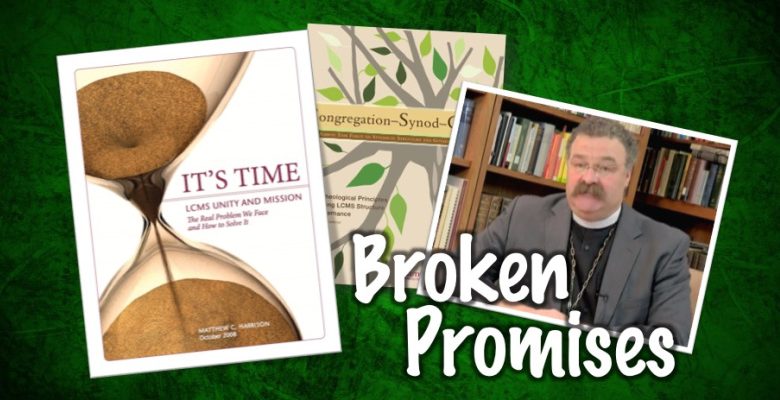National Synod Restructuring: What Was Promised, What We Got
In 2010, the LCMS adopted sweeping changes to the Handbook of the Synod, designed to streamline the work of the national office. The “Blue Ribbon Task Force” report (click HERE to download a copy) desired to cause Synod’s work to be more responsive to the congregations of the Synod.
Here’s the strange twist: while the convention adopted the “Blue Ribbon Taskforce” changes, delegates also strangely (and certainly ironically) then elected as President a man who opposed the changes, Matthew Harrison.
Have we gotten what we voted for — or just more broken promises?
Bottom-Up Prioritization of National Synod Works
What was intended: local congregations should be the focal point of ministry in the LCMS, not the national church body or even the districts. (That’s a biblical principle. See the Structure task force’s theological document Congregation-Synod-Church, p. 11. In fact, read the whole thing; it’s worth it!)
The Task Force recommended changes so that the national church body would not be caught up in activities inconsistent with local congregations’ desires – or helpful to them. A system was put in place whereby local congregations and groups of congregations in circuits could, through their district conventions, determine a narrow list of priorities upon which the national office could focus (Bylaws 3.1.1, 4.2.1 (d), 5.3.4). This would provide leadership at the national office its marching orders.
What we got: the floor committees appointed by the President of the Synod produced resolutions with lengthy, non-specific lists that could encompass a wide variety of activities, while affirming the top-down “Witness, Mercy, Life Together” slogan (see 2013 National Convention Resolution 3-06A and 2016 Resolution 4-02A as examples. You can download the convention proceedings here).
Leaner, Fiscally Responsible National Office
What was intended: the narrowed list of priorities (above) should lead to a leaner staff at the national level, consuming fewer of the congregations’ precious resources. This eliminated many program boards (we’re now down to two). This also eliminated the long list of mandated tasks to be accomplished by Synod (one of the primary causes of the fiscal difficulties that existed in 2010). The national office was enabled to focus on what congregations REALLY wanted done AND live within its fiscal means.
What we got: with all the tools the current administration has, the Synod STILL is not living within its means. Click below to read Congregations Matter articles about:
- Synod’s lack of financial transparency, or
- $500K of broken promises to fund our Seminaries, or
- the secret sale of Hong Kong properties to fund Synod, or
- keeping Hurricane Relief funds in St. Louis to cover cash flow problems!
AND MORE. The Synod is venturing into work such as planting new congregations (click here to read more). Isn’t that what congregations and districts are supposed to do?
Empowering Congregations Through Their Districts
What was intended: a grass-roots, congregation-centered Synod. In such a Synod local congregations lead the way and district and Synod officials and staff support and encourage them. That’s what the Synod Constitution says should happen (Click here to download a copy). That’s also the Synod that our first president, CFW Walther, envisioned (Click here to download a copy of Walther’s first presidential address).
What we got: moves to restrict the work of congregations in foreign mission fields (CCM Opinion 14-2724), increased centralized control of our universities and seminaries (click here to read Congregations Matter’s article on Synod blackballing presidential candidates), centralized ecclesiastical supervision (click here to read Congregations Matter’s article), etc.
A Synod President Who is the Servant of Congregations
What was intended: the Structure Task Force AGREED with the ideas in President Harrison’s campaign manifesto “It’s Time” (Click HERE to download a copy). The Synod restructured to make sure “the answers to local problems are local” (see page 6, right column, middle). The Task Force agreed when Harrison decried constant fund-raising for the national office (see page 6, left column, bottom). The Task Force supported Harrison’s comment “The Synod should exist to serve and increase local capacity” (see page 6, left column, last full paragraph), and that “centralized bureaucracy” manages to “squeeze out the Gospel” (see page 6, left column, middle). The recommendations of the task force were in line with those ideas.
What we got: exactly what President Harrison decried in his campaign material. He has moved to centralize more activity and power in the national office, take decisions away from local congregations and districts, and imposed himself as the direct “ecclesiastical supervisor” of all church workers in Synod (click HERE to read the Congregations Matter article). Congregations are now serving the centralized authority of President Harrison’s office rather than the national office (and the Synod’s President) serving congregations.
Responsibility for Work of National Office Ultimately on President’s Desk
What was intended: the buck for the work of the national office stops at the desk of the Synod President, unlike the previous model where leadership of the national office was so diffuse it was hard to hold anyone accountable.
What we got: Exactly that! The failures of the current Synod fall directly on the desk of the President.
“It’s Time” for a Change
Join our movement. Let’s nominate and elect a Synod President who will fulfill the promises of restructuring and live up to his own.
The LCMS is a “bottom-up” Synod of congregations walking together, not a “top-down,” centralized organization (click HERE to read more about it). Synod should serve congregations instead of congregations serving Synod.
Until we have a leader who believes and acts that way, we will continue to live with the unfulfilled promises of the restructuring — and the broken promises of President Harrison.
Congregations — and Synod serving congregations — matter.

